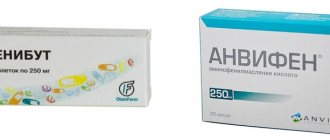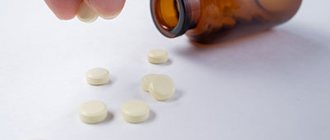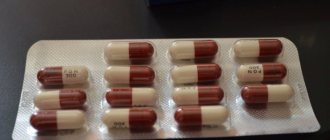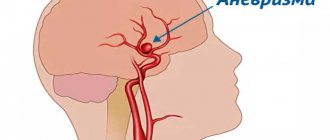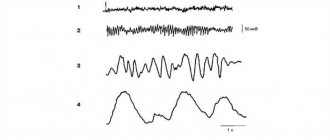Moderate poisoning
An overdose of Phenazepam in this form is accompanied by a more pronounced clinical picture:
- impaired swallowing reflex and tongue retraction
- severe constriction of the pupils and lack of reaction to light
- suppression of the cough reflex
- deterioration in muscle contractility
- lack of closure of the palpebral fissure in response to exposure to the cornea
A superficial coma is possible, which is accompanied by loss of consciousness and erratic movements in response to painful stimuli. In this case, it is impossible to wake the patient. In this condition, vomiting is possible, which is life-threatening.
Severe form
Symptoms of a severe overdose of Phenazepam:
- lack of reflexes
- agony
- dilated pupils
- reduction in blood pressure to critical levels
- respiratory depression
- increased heart rate
- critical decrease in body temperature
- deep coma
In the absence of intensive care, death occurs from Phenazepam.
Chronic form of poisoning
This form is possible with regular, slight excess of the dosage recommended by the doctor. In this case, the patient encounters the following symptoms:
- limb tremors
- feeling of unreasonable anxiety
- weakness
- fatigue
- drowsiness
- migraine headaches
- increased excitability
In severe cases, seizures and hallucinations are possible. The chronic form of intoxication is dangerous and requires treatment.
Content:
- When does an overdose of Phenazepam occur?
- Consequences of an overdose of Phenazepam - symptoms.
- Chronic form of pathology.
- Diagnostics.
- How to provide first aid to a victim.
- Complications of an overdose of Phenazepam.
Phenazepam is a tranquilizer; the drug calms the nervous system, relieves anxiety, eliminates obsessive thoughts and fears, and helps normalize sleep. An overdose of Phenazepam can have the most serious consequences - from daytime drowsiness to coma and death.
The medicine is usually prescribed by psychiatrists and psychotherapists for insomnia, anxiety disorders, and to alleviate hangover syndrome as part of complex therapy. Available in pharmacies strictly according to prescription.
General information
Phenazepam is the first tranquilizer, which was originally used as an anesthetic for surgical procedures. Over time, the scope of application was expanded - the drug began to be included in the treatment of depression, insomnia, epilepsy, neuroses, and anxiety disorders. The drug helps relieve some clinical manifestations of withdrawal syndrome when giving up alcohol.
The drug is addictive and causes a feeling of mild euphoria. For this reason, Phenazepam is actively used by drug addicts. To enhance the effect, the medication is mixed with alcohol, sleeping pills, and other drugs.
When does an overdose of phenazepam occur?
Despite the fact that Phenazepam is an excellent remedy for many pathological conditions, doctors often encounter an overdose of this pharmaceutical. The fact is that this medicine is quickly addictive, as a result of which people often independently increase the permissible dosage. The consequences of this can be: suicidal thoughts, impaired memory and coordination of movements, depression and even fainting.
In addition to cases where the pathology is caused by an increase in the daily dose, suicide attempts occur. People who decide to commit suicide take prohibitively large amounts of pharmaceuticals.
Another fairly common phenomenon is drug addiction. Just as a person becomes “addicted” to drugs or alcohol, he or she will be able to become unnoticed when taking a medication. This phenomenon is called “pharmacy drug addiction”; the consequences of an excess of Phenazepam are completely unpredictable.
Drug addiction treatment
If, based on test results, dependence on Phenazepam has been confirmed, it is important to start therapy in a timely manner. This will help reduce the negative impact of tranquilizers on internal organs, the central nervous system and reduce the risk of death. The only antidote is flumazeline. At the same time, the dose of Phenazepam is gradually reduced, bringing it to a safe daily dose.
The tranquilizer is completely discontinued as soon as the drug addict’s condition has stabilized.
Detoxification is carried out simultaneously with drug therapy. In the case of benzodiazepine tranquilizers, the following methods can be used:
1. Forced diuresis
The patient is given a diuretic intravenously. Typically these are sodium chloride and glucose. Before prescribing this method, the drug addict's medical history is examined for the presence of chronic kidney damage. The volume of urine excreted is also taken into account. During the drip, the condition is carefully monitored.
2. Enterosorption
Fanezapam is absorbed by the walls of the stomach. The faster you rid the digestive system of benzodiazepine, the faster the condition will stabilize. In a hospital setting, an enema or probe is usually used. Additionally, a sorbent is given, which enhances the effect of drugs for cleaning the gastrointestinal tract.
3. Hardware blood purification
Tranquilizers negatively affect the liver. Blood purification together with hepatoprotectors helps restore the functioning of the organ. There are several options:
- hemosorption - a certain volume of blood is passed through a filter and then introduced into the body;
- plasmapheresis - the cell mass separated from the plasma is diluted with physiological solution in a ratio of 1 to 1 and also injected into a vein.
When taking tranquilizers in large quantities, the central nervous system is primarily affected. To restore it, a course of vitamin therapy is carried out using B vitamins. Additionally, the treating physician may prescribe limontar to restore energy metabolism, and piracetam to improve blood supply to the brain.
How addiction is formed
There are three stages in the development of drug addiction. The first is psychological. At this stage, a person forms a clear “drug-pleasure” connection. But over time, tolerance decreases and a larger volume is required to obtain the same sensations. Without another injection, it becomes more difficult for addicts to perform their duties at work.
The second stage is physical dependence. Functional disorders may appear, which are better known as withdrawal syndrome or “withdrawal.” The severity of the clinical picture depends directly on individual characteristics.
The third stage is the final stage. The body often experiences irreversible mental and physical changes. Interest in the surrounding world is lost, behavior is not controlled.
How long do drug addicts live?
Phenazepam itself cannot cause death, even if taken in non-therapeutic dosages. The risk of death is high for drug addicts with a large number of chronic diseases. Age is also of great importance - the older the addict, the faster his internal organs will fail.
A fatal outcome is most likely due to withdrawal symptoms. The clinical picture of withdrawal syndrome is accompanied by a large number of unpleasant and painful sensations. To eliminate them, too large a dose is administered, which leads to death. The outcome is also affected by the simultaneous use of alcohol, analgesics and narcotic components.
Rehabilitation
Drug addiction therapy is a complex undertaking. This means that along with drug treatment, the addict needs serious psychological support. This is the only way to achieve remission and reduce the risk of returning to drugs.
During group and individual meetings with a psychologist, the reasons that prompted a person to take a pharmaceutical drug are determined. Scenarios for safe solutions must be worked out. They also pay attention to the analysis of the sensations that the addict experienced while taking Phenazepam, and possible ways to obtain them using healthy methods.
Non-drug methods are also effective in rehabilitation. For example, yoga classes.
Why you can’t treat yourself at home
Like other drugs that affect the central nervous system, Phenazepam should be discontinued gradually. A sharp refusal increases aggressiveness and suicidal thoughts. Such conditions require adequate actions, the implementation of which requires specialized education.
Phenazepam intoxication is often accompanied by severe headaches. It is impossible to treat them with standard drugs. This may lead to you taking another dose.
Working with codependents
In addiction treatment, codependents are usually called people who live directly with an addict. This could be parents, wife/husband, children. Over time, they cease to adequately respond to drug addiction, often finding excuses for it. In such conditions, it is impossible to achieve stable remission.
Rehabilitation centers are developing special programs for codependents. They involve working with a psychologist, lectures and meetings. All information related to dependence on Phenazepam must be presented. The main task is to achieve persistent rejection of the current situation.
Ambulatory treatment
Another part of drug addiction treatment. This stage is started only if there is psychological readiness of the drug addict, his family and successful completion of the medication program. By the time outpatient treatment begins, a person must completely stop communicating with people who drink alcohol, use drugs, or smoke.
The duration of the course can be up to six months. It is mandatory to visit a narcologist or psychologist throughout this time according to the established schedule. And also take vitamins, maintain a healthy lifestyle and adhere to the rules of a balanced diet. Listening to thematic seminars, lectures, meetings with former drug addicts who have successfully recovered from addiction are also part of outpatient treatment.
Resocialization
During the time when a person is dependent on drugs, he loses his previous social connections, work or study. Without returning to society, it is impossible to achieve remission. Resocialization usually occurs in two stages.
The first one is group. Former addicts who have successfully completed treatment live in small groups outside the rehabilitation center. Here they learn to be members of society, interact with each other, and perform certain duties. Retraining courses can be organized.
The second stage is home. Without a program for working with codependents, it is not advisable. If yesterday's drug addict is not supported by loved ones or he returns to his previous environment, there is a high risk that addiction will develop again.
How to quit on your own
Any self-medication entails serious consequences. Drug addiction is no exception. Patients often refuse to go to a medical facility for fear of publicity. But it is impossible to cope with withdrawal symptoms without medical supervision. Mental problems in this case will only get worse, which, against the background of suicidal thoughts after taking Phenazepam, can lead to death.
The addict may try to cut ties with others who also use drugs or alcohol. But it is extremely difficult to do this without the support of a psychologist.
Bibliography:
- Intravenous drug administration.
- Principles and stages of the treatment and rehabilitation process in narcology.
- Federal clinical guidelines for the diagnosis and treatment of withdrawal syndrome.
- Author Veronica Dovnich
Editor Artyom Emelyanenko
Consequences of an overdose of Phenazepam - symptoms
At the first sign of an “overdose” in an adult or child, you should immediately consult a doctor. Symptoms of phenazepam poisoning manifest themselves differently, depending on the severity.
- In a mild form, the symptoms are almost invisible both to the person himself and to those around him. Weakness, slight drowsiness, ringing in the ears appear, and sometimes general health worsens. Doctors determine the consequences of such an overdose based on complaints; there are also objective manifestations: drooping of the upper eyelids, involuntary movements of the eyeballs.
- The consequences of slightly exceeding the permissible dose do not adversely affect health; they usually disappear after a night's sleep.
- In a condition of moderate severity, the symptoms are more clearly expressed. This is a retraction of the tongue with a violation of the swallowing process, muscle weakness, general lethargy, and some lethargy. The pupils narrow and react poorly to light.
- Sometimes there is a superficial coma, loss of consciousness, which is often mistaken for sleep. However, it is not possible to wake the person. The most dangerous thing in this case is the appearance of vomiting; the patient risks choking. Therefore, it is very important to urgently call an ambulance if such signs are present.
- The severe form is accompanied by deep coma, agony, and a complete absence of reflexes. Respiratory activity is depressed, the heartbeat is rapid, blood pressure drops to critically low values, and body temperature also drops sharply.
The consequences of severe overdose require immediate intensive care; without it, death is possible.
Excretion from the body
Antibodies and metabolites of Phenazepam are stored in various biological materials and tissues. The half-life ranges from 6 to 18 hours. In the blood and urine, the content of the drug decreases by half after 12 hours. If the volume of the substance does not exceed 2 mg, the body will take about 3 days to completely eliminate it.
In hair and nails, Phenazepam metabolites are detected by laboratory tests for up to 3 months.
The process of cleansing the body is influenced by several factors:
- metabolism;
- taking other medications;
- age;
- individual characteristics of the nervous system;
- the presence of chronic kidney and liver damage.
How to speed up elimination from the body at home
It is impossible to completely cope with the negative impact of Phenazepam and its metabolites on internal organs at home. Independent actions should be limited to gastric lavage.
For this procedure, you can use a solution of activated carbon, at the rate of 1 g per kilogram of weight, and 300 ml of water. You can also use soda - 2 liters of liquid and 1 tbsp. l. If a person does not experience attacks of nausea or vomiting, he is given Magnesium Sulfate according to the instructions.
Detoxification in hospital
Cleansing in a medical facility begins with gastric lavage if the patient was brought in from the street or it was not possible to carry out the procedure at home. If a person is unconscious, first intubate the trachea and remove accumulated vomit and mucus.
It is advisable to lavage the stomach and take enterosorbents if no more than 10 hours have passed since the last use. For enterosorption, the following drugs are most often used:
- colloidal silicon dioxide;
- povidone;
- polymethylsiloxane polyhydrate.
Before use, these drugs are dissolved in 100 ml of boiled water at room temperature.
After cleansing the intestines, 0.3–0.6 mg of flumazelin is administered intravenously. Additionally, a solution of electrolytes at the rate of 10–20 ml per 1 kg of weight. To relieve the clinical picture of acute poisoning, a dropper with meglumine sodium succinate is recommended. Thiamine and pyridoxine support a weakened immune system. Nootropic drugs (for example, piracetam) help eliminate disorders of the central nervous system.
In severe cases, detoxification involves the use of the following drugs:
- potassium chloride solution (only if diuresis is not impaired);
- magnesium sulfate solution;
- colloid solution;
- a nicotinic acid;
- ascorbic acid;
- cyanocobalamin;
- thioctic acid;
- ademetionine.
The dosage of these drugs is determined only by a doctor.
Hemosorption or plasmapheresis may be required. Additionally, symptomatic treatment of complications is prescribed.
Chronic form of pathology
Doctors often encounter cases where a patient takes the prescribed drug regularly, but slightly exceeds the recommended dosage. Such patients complain of constant drowsiness, fatigue, muscle weakness, and increased excitability. They are tormented by anxiety, tearfulness, migraine-type headaches, and sometimes hallucinations.
Objectively, shaking (tremor) of the arms and legs is observed, and convulsive manifestations are often noticeable. Taking this medication in combination with large doses of alcohol is especially dangerous. The consequences of overdose in this case require mandatory treatment and observation by a specialist.
PsyAndNeuro.ru
In recent years, we have seen ongoing controversy regarding the use of antidepressants. On the one hand, treatment of depression with antidepressants leads to a reduction in the risk of suicide at the epidemiological level1. This is consistent with the high population risk of suicidal ideation and suicide attempts in people with mood disorders, estimated at 51% and 44%, respectively2, and with studies of the history of depressive episodes in completed suicides (approximately 60%). On the other hand, the likely occurrence or increase in the risk of suicide early in treatment, at least among younger patients, has prompted regulatory authorities to issue special warnings. As a consequence of these warnings, the prescription of antidepressants has decreased, including among adult patients, and research into the suicidality effects of antidepressants has been encouraged. There is an urgent need to address concerns about the benefits of antidepressants in treating patients who are or may be suicidal.
The controversy began in 2003, when a new analysis of data from randomized controlled trials (RCTs) showed that the risk of suicidal ideation or suicide attempts in young patients taking antidepressants was doubled compared with those taking placebo (4% vs. 2%) , regardless of the indication for which they were prescribed (see review by Brent3). Later, a meta-analysis of RCTs without age restrictions showed an increased risk of “suicidality” when treated with antidepressants in patients under the age of 25 years. Note that the risk was found only in hospital patients receiving antidepressants for other indications than depression, while in elderly patients with depression antidepressants reduced this risk4. A significant drawback is that reports of suicide attempts are taken from RCTs, most of which are not designed to study suicidality. However, the warnings—along with troubling media coverage—led to doctors prescribing fewer antidepressants even when there were no alternatives available.
The use of antidepressants to prevent suicidal behavior is supported by several facts. First, most pharmacoepidemiological studies that are more representative than RCTs demonstrate a positive effect of antidepressants in preventing suicide1. Second, although observational studies suggest that the risk of suicidal ideation is increased in young people taking antidepressants, the risk is actually reduced when the reason for prescribing is taken into account3. Third, autopsy toxicology studies of antidepressants show that suicide is more likely to be committed by depressed patients not taking antidepressants1.
In addition, there is an opportunity to minimize treatment-related suicides. Guidelines from the US FDA and the UK's National Institute for Health and Care Excellence recommend close monitoring of antidepressant treatment in suicidal patients or patients under 30 years of age, with a follow-up visit one week after starting a new antidepressant. In the near future, Internet resources and smartphone applications will improve the quality of monitoring of patients at risk. On the other hand, patients with depression are often inconsistent in treatment, which has led some authors to question whether antidepressants have any effect, positive or negative, on suicide rates in the general population6.
This controversial context also influences research on the topic, but few observational studies have examined predictors of de novo suicidal behavior in depressed patients starting an antidepressant5,7. Generally speaking, treatment-induced suicidal ideation is rare in adults and tends to progressively decrease over the first 4 to 6 weeks of treatment. The best predictors of suicidal ideation and suicide attempts are lack of response to treatment, past suicide attempts, and substance abuse. It is worth noting that starting treatment with high (above recommended) doses of antidepressants likely increases the risk of suicidal ideation or suicide attempts5.
Suicidal attempts at the start of antidepressant treatment may also be associated with undiagnosed bipolar disorder, the presence of which can be judged by the early onset of depression and atypical depressive episodes. Moreover, the age factor in suicidal ideation and attempts is likely due to the fact that the association of substance use and impulsive aggression with depression is more common in youth.
All this leads to the need to change the paradigm of treatment of suicidal patients. Clinical response to antidepressant treatment is poorer in patients with a history of suicidal ideation or suicide attempts, regardless of associated factors or type of antidepressant7. Those most in need of effective treatment respond less well to treatment. Further development of RCTs targeting depressed patients at risk for suicide will help determine short-term treatment strategies for these patients.
Several possible treatments for suicidal patients deserve more thorough study: first, the combination of lithium or antipsychotics with antidepressants; secondly, the almost instantaneous and radical anti-suicidal effect of low doses of ketamine. This effect is particularly interesting and may be explained by effects on glutamatergic neurotransmission in the anterior cingulate cortex5. There is growing evidence regarding the role of social, psychological, and physical pain in suicidal behavior. The mu-opioid receptor system is involved not only in the experience of physical pain, but also in the pain of social rejection, and is a suitable target for suicide prevention. A four-week study of patients with suicidal ideation found that an ultra-low dose of sublingual buprenorphine was more effective than placebo in reducing suicidal ideation8.
Caution should be urged due to the current risk that psychiatric patients may take advantage of the option of euthanasia. Legal euthanasia should not become a manifestation of therapeutic nihilism9. In the presence of a mental disorder, the use of proven treatments and available anti-suicide strategies is ethically imperative.
Translation into Russian was organized by the Council of Young Scientists of the Russian Society of Psychiatrists with the support of the World Psychiatric Association.
Prepared by: Filippov D.S., Potanin S.S.
Source: Courtet P. et al. Antidepressants and suicide risk in depression. World Psychiatry. Oct 2021; 16(3): 317–318.
Bibliography:
- Isaacsson G, Rich C. Eur Psychiatr Rev 2008;1:24-6
- Nock MK, Hwang I, Sampson NA et al. Mol Psychiatry 2010;15:868-76
- Brent DA. Psychiatr Clin North Am 2016;39:503-12.
- Stone M, Laughren T, Jones ML et al. BMJ 2009;339:b2880.
- Courtet P, Nobile B, Lopez-Castroman J. In: Kumar U (ed). Handbook of suicidal behavior. Bangalore: Springer Nature (in press).
- Simon G BMJ 2008;336:515-6.
- Lopez-Castroman J, Jaussent I, Gorwood P et al. Depress Anxiety 2016;33:483-94.
- Yovell Y, Bar G, Mashiah M et al. Am J Psychiatry 2016;173:491-98.
- Olie E, Courtet P. JAMA 2016;316:656-7.
